Top News
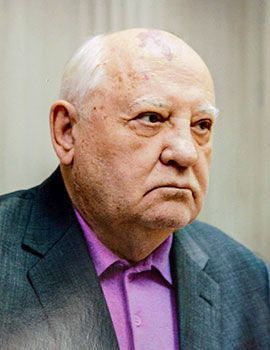
January 31, 2018 Ryukyu Shimpo
Spurred by concerns about the rising threat of nuclear weapons, Mikhail Gorbachev (86), former president of the Soviet Union, Nobel Peace Prize winner, and leading figure in bringing the Cold War to a close, sent a message to the people of Okinawa through the Ryukyu Shimpo. In it, he expressed his concern that there might still be nuclear weapons stored in Okinawa, and stated that the truth must be disclosed to the Okinawan people. Gorbachev emphasized his support the Okinawans’ struggle against military base expansion and called for the exercise of Okinawan self-determination, saying that Okinawa must continue to be not an island of military bases, but an island for the Okinawan people.
Gorbachev stated in the message that he learned that many nuclear weapons were stationed in Okinawa during the Cold War from the program “NHK Special: Okinawa and Nuclear Weapons” broadcast last year by NHK. He expressed his concern that nuclear weapons might still be being stored in Okinawa.
Gorbachev also discussed his active efforts to promote nuclear disarmament, including the joint statement by himself and then-U.S. President Ronald Regan in 1985, in which they emphasized that a nuclear war must never be fought. He expressed his support for the movement opposing the construction of a new base in Henoko, Nago, stating that he “support[s] the struggle against military expansion in Okinawa by the people of Okinawa.”
He wrote that Okinawa is home to a unique natural environment and a distinctive culture and emphasized that Okinawa should aim for peaceful development as a “terminal for international human and cultural exchange.”
According to an acquaintance of Gorbachev, he expressed awe at the beauty of Okinawa’s coasts on his three visits to the prefecture and used the term “self-determination,” saying, “If, despite living in such a blessed environment, Okinawans don’t realize those characteristics and are by their own hand closing off sufficient possibilities for a richer tomorrow, it is a terrible shame. For the sake of the children of future generations, I want Okinawans to consider that peaceful and rich development are within their grasp,” and calling for the exercise of the right to self-determination.
Summary of Gorbachev’s message:
Message sent to Okinawans by Gorbachev
Knowing now about the presence of nuclear weapons in Okinawa during the Cold War era, as revealed in a recent NHK program, my heart aches with concern that there could still be nuclear weapons stored in Okinawa. It is essential that the truth be disclosed to the residents of Okinawa.
I have always stood up for nuclear disarmament and ultimately a complete abolition of nuclear weapons. At the same time I have argued against the use of military force in resolving international disputes. From this perspective I have invariably supported the struggle against military expansion in Okinawa by the people of Okinawa, and I will support it from here on out.
Okinawa’s rich nature and distinctive culture make it unique in this world. Therefore the islands of Okinawa must be for the people, not for the military.
Okinawa is blessed with an environment that allows it to be a terminal for international human and cultural exchange as well as trade. It is my sincere hope that Okinawan people take advantage of this rich environment and aim for peaceful development of the islands, for the sake of future generations.
(Article translation by T&CT and Sandi Aritza; translation of Gorbachev’s message by Satoko Norimatsu with assistance by Erin Jones)
Go To Japanese
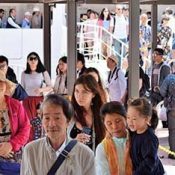
February 2, 2018 Ryukyu Shimpo
The Hawaii Tourism Authority announced on February 1 that the number of tourists to come to Hawaii in 2017 was 9,382,986. Tourists to Okinawa exceeded those to Hawaii for the first time, by a margin of about 13,000 people. In 2017, the number of tourists arriving in Okinawa Prefecture was 9,396,200.
The number of tourists to visit Okinawa increased by 783,100 (9.1%) compared to the previous year and marked the record high for a fifth consecutive year, bolstered by the dramatic growth of foreign tourism and a rising number of port calls by cruise ships. Tourism to Hawaii also increased by 448,709 people (5.0%) compared to the previous year, and has reached the record high for a sixth consecutive year.
People in the tourism industry in Okinawa welcomed the news that the number of tourists to Okinawa exceeded those to the world-famous resort destination of Hawaii. They also expressed their willingness to further promote tourism, and mentioned their desire to be on-par with Hawaii in terms of the tourists’ lenth of stay and sum of expenditures.
Since hotel companies in Okinawa observed Hawaii as a model destination in 1968, parts of Okinawa have been developed to resemble the beach and hotel environment in Hawaii. The public and private sectors strategically worked together to create an image of “Resort Destination Okinawa.”
(English translation by T&CT and Megumi Chibana)
Go To Japanese
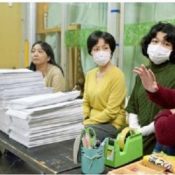
February 1, 2018 Ryukyu Shimpo
Following the incident where parts fell from an U.S. military aircraft, 100,456 signatures were collected by January 31 by the Midorigaoka Nursery’s Parents’ Association.
The petition called for the suspension of flights by U.S. military aircrafts above the nursery.
The parents’ association set the deadline for the petition and tallied the signatures on the same day.
The signatures were collected over 52 days. The plan is for the parents’ association to travel to Tokyo on February 13 and 14 to hand the petition to the proper government agencies.
The petition also calls for the investigation into the cause of the parts falling and the suspension of flights by U.S. military aircrafts until the cause is determined.
The goal at the start of the petition was only 10-thousand signatures.
Tallying up the signatures took from 2 p.m. to the evening.
About 20 parents participated in the tallying during their spare time outside of work.
The parents shouted with joy when they reached the 100-thousandth signature.
Even while the parents were busy tallying the signatures, U.S. military aircrafts were flying above the nursery.
Parents’ Association President Tomoko Miyagi, 48, appreciated everyone’s effort.
She said, “When we first began this petition, we weren’t expecting to collect these many signatures.
Every day, we received signed forms and letters.
We became filled with emotion over people’s determination to collect them from all across Japan.”
During their visit to Tokyo, the parents’ association plans to submit the petition to the Ministry of Defense, Ministry of Foreign Affairs, and Cabinet Office.
They plan to hold a press conference at a Lower House meeting in which they will invite Diet members.
The parents plan to contact the Diet members individually to request their presence at the Lower House meeting.
They also plan to hold another press conference at the Foreign Correspondents’ Club of Japan.
Parents’ Association Secretary Chiemi Yonagusuku, 44, who proposed the petition, was determined.
She said, “We will take everyone’s hopes to Tokyo.
We want to tell them to protect the children.”
(English translation by T&CT and Chelsea Ashimine)
Go to Japanese
February 2, 2018 Ryukyu Shimpo
On January 1 the Okinawa Prefectural Assembly unanimously adopted a protest resolution and written statement at an extraordinary session in response to issues with U.S. military helicopters.
These issues include recent successive emergency landings by U.S. military helicopters, the incident in which a window part from a helicopter fell onto the grounds of Futenma Daini Elementary School, and helicopters flying in the sky over this school.
Instead of waiting for the closure of Futenma Air Station in February 2019, within the five-year period promised to the Okinawa Prefectural Government by the Government of Japan, the resolution and statement request an immediate closure of the base.
They also request that U.S. military flight exercises over schools, hospitals, or residences be halted.
This is the first time the Prefectural Assembly has requested an immediate closure of Futenma Air Station.
Furthermore, the resolution and statement request that (1) the U.S.-Japan Status of Forces Agreement be drastically revised, the Act on Special Provisions of the Civil Aeronautics Act based on the SOFA be abolished so that the U.S. military will be subject to Japan’s civil aeronautics law, and that (2) the U.S Marine Corps be relocated out of Okinawa and out of Japan quickly.
The resolution and statement indicate that, “It is highly unusual for three consecutive emergency landing incidents to occur within the period of only about half of a month.”
Moreover, the documents criticized that even after the incident of a helicopter window part falling onto the grounds of Futenma Daini Elementary, “those calling to ban flying over schools have simply been ignored.”
In addition, these documents point out that flight exercises were resumed before an adequate explanation into the cause of the incidents was provided.
Already Okinawans’ calls for the withdrawal of the Marines Corps from Okinawa are spreading.
The Prefectural Assembly is currently working out the details of its plan to submit the resolution and statement next week to the U.S. Forces Japan in Okinawa, the U.S. Consulate in Okinawa, the Ministry of Foreign Affairs’ Okinawa Liaison Office, the Okinawa Defense Bureau, and perhaps others.
(English translation by T&CT and Erin Jones)
Go to Japanese
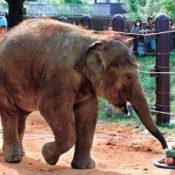
January 23, 2018 Ryukyu Shimpo
A female Indian elephant named Rubi raised at the Okinawa Zoo & Museum in Okinawa died on January 22. She lived for two years and ten months. Her appetite and health condition had declined a few days before her passing. The Okinawa Zoo & Museum will hold a press conference on January 23 to explain the cause of her death. Rubi was the first elephant born in Okinawa, and many visitors loved her.
Rubi was born March 4, 2015. Her name was sought from 6,138 publicly offerred names by choosing the most popular one with the Chinese character of 琉美. The pronunciation was chosen by her mother Ruka who drew the lot.
Many customers and zoo workers celebrated her birthday every year, watching her grow with the mother elephant Ruka.
“Everyone’s treasure”
Head zookeper Masaru Takada reflected and shared thanks to the late baby elephant, commenting “Rubi was loved by many visitors, and she was everyone’s treasure. Since she was born, every single thing about her was a new experience for our workers, and it was a learning process.”
(English translation by T&CT and Sayaka Sakuma)
Go to Japanese

February 2, 2018 Ryukyu Shimpo
By Sanemichi Kinjo
Actress and on-screen personality Riria, who works in Taiwan and is a native of Ishigaki Island in Okinawa, recently visited the Ryukyu Shimpo offices to talk about being a celebrity in Taiwan and share her thoughts on Okinawa. “I want my work as an entertainer to become the bridge between Okinawa and Taiwan, and to strengthen the interactions between the two,” she said enthusiastically.
Riria was born in Tokyo, but raised on Ishigaki Island.
After graduating high school, she worked on mainland Japan for a time before going to Taiwan to study Chinese.
She was discovered by a scout while on campus at her university in Taipei, after which she appeared in her first commercial.
Since 2010, in addition to working as an actress and on-screen personality both on TV and in movies, she has also worked as an emcee, interpreter, and Japanese-language acting coach.
“Through a series of strange chances, I wound up appearing on TV.
I think I was able to introduce [Taiwan] to Okinawa as an on-screen personality, and was able to give some quiet PR for Okinawa as well,” she said smiling.
Since Riria was young, she has been a great cook.
Appearing in many cooking shows in Taiwan gave her the opportunity to release a recipe book that features Ryukyu dishes made with ingredients such as vegetables and fruits that can be bought in Taiwan titled, “Okinawan Recipes eaten by Japanese people to keep you looking young.”
“Ryukyu food is also popular in Taiwan. The book is a collection of pictures I took over a number of days of different types of dishes I made myself, including things like Taiwanese bitter gourd and grilled mince-meat and cheese,” she said.
This spring she will also release a guide for Taiwanese travelers visiting Okinawa that includes things like tips for preventing traffic accidents.
I am creating a travel guide for people traveling around the island by rental car.
It covers all of Okinawa, and introduces safe driving habits.”
Last July, she was also appointed the Taiwan international tourism adviser for Yaeyama.
Riria commented on the appointment saying, “There are a lot of Taiwanese who want to travel to Okinawa, but the number of Okinawans traveling to Taiwan is still small.
Taiwanese food is delicious, and the city and traditional culture is marvelous.
I want to stay active doing what I can to strengthen the interaction between Okinawa and Taiwan.”
(English translation by T&CT and Sam Grieb)
Go to Japanese
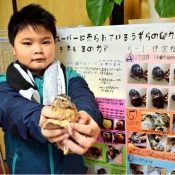
January 15, 2018 Ryukyu Shimpo
Ten-year-old Isshin Nakasone, fifth-grade student at Hagoromo Elementary School in Ginowan, successfully hatched five quails out of 19 eggs that he bought at a store last June. According to his mother Eri ,38, they did not have many expectations before they started the hatching process. However, with a great surprise, one of the surviving birds calls cheerfully to this day.
Isshin likes animals and takes care of two pairs of tortoises and iguanas. He especially loves hatching eggs and raising baby animals. He commented on the quails, saying “they were really cute,” and he also made a one-meter tall poster to explain the hatching process. The poster received a gold award at his school.
When the egg incubation project started, Isshin had been having difficulty going to school. Now he has gained great confidence after raising the quails and grew through the process. As her son insists he can raise quails again, Eri responses with a worrying smile, saying “there is no more room.” She continues as she smiles, “we parents want to trust our children, let them do what they are interested in, and help them grow.”
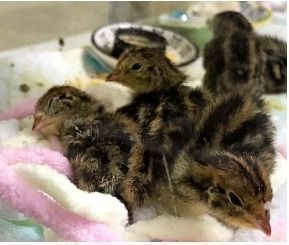
Baby quails hatched from eggs sold at a store
There is an array of tanks for his animals in the apartment in Ginowan where the family lives. The boy was determined to take care of birds, so he studied how to raise them and convinced his mother who previously said “we won’t have any more animals in house.” He bought two packs of quail eggs from a neighboring super market with his pocket money on May 28.
He placed 19 eggs, except for one cracked one, in a case filled with cotton and thermal equipment for turtles to control temperature and humidity. Checking the eggs was the first thing he did every morning, and his 14 years old sister Kokona also took care of the eggs by rotating them every three to four hours. He also did not stop taking care of them on the days he could not attend his school.
Eight days after the project started, they were able to observe growing blood vessels in eight eggs when they held the, under lights. Isshin was excited about the possibiltiy for having all eight eggs hatch, and recorded the development process throughly on photos.
Most eggs sold at stores are usually infertile and do not hatch. His mother Eri laughs while saying, “We heard that it’s hard to tell a quails’ sex and that the eggs sold in stores tend to have more sperm eggs by accident. But I didn’t think eight of them would hatch. So while I was excited, I worried what we would do with them.”
They watched the eggs every couple of days by placing them under a light, but since they learned it is better to leave them untouched, they waited in patience after day 13. The baby birds started calling in their egg shells, and the first egg finally hatched on day 16. Five birds hatched in three days.
There were many discoveries as they hatched the quails – the babies start walking right after they hatch, the baby quails eat by themselves, they sleep face-down with their legs spread “as if they were dead” and although each bird has different patterns on their feathers it becoms difficult to notice once they are grown. The family enjoyed having active conversations while raising the birds.
Isshin currently goes to an adaptation class hosted by the city educational board away from his regular school. His mother, Eri smiles, “we were worried about him not going to school, there wasn’t much to be done since he himself wanted to go to school but could not. We want to nurture our trusting relationship with our child and work with him to do what he wants to do.”
(English translation by T&CT and Sayaka Sakuma)
Go To Japanese
January 27, 2018 Ryukyu Shimpo
With the concentration of U.S. military bases on Okinawa, accidents and trouble caused by U.S. military aircraft are never-ending. Many incidents have occurred that injure and kill Okinawans, and their way of life has come to be threatened by military aircraft. On June 30, 1959 in Uruma City (in what was Ishikawa City at the time) a U.S. military jet crashed on Miyamori Elementary School. The accident resulted in 18 fatalities 11 of which were elementary school pupils, and over 200 people injured. Two years after the school incident another U.S. military jet crashed in Kawasaki, Uruma City (which was previously Kujikawa Village), killing two local citizens.
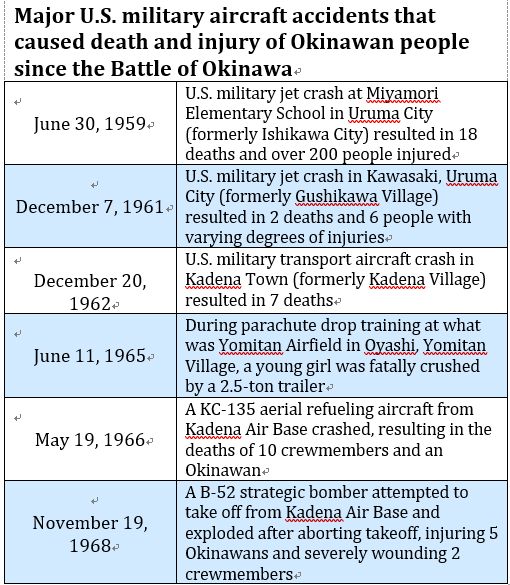
In 2004 a U.S. Marine Corps CH-53D large transport helicopter crashed on the grounds of Okinawa International University, although no Okinawans were injured in this incident. There are also many instances in which small errors could turn into catastrophes. One such instance was in December 2016 when an MV-22 Osprey vertical takeoff and landing aircraft from MCAS Futenma crashed off the coast in Abu, Nago City. Another example was in October 2017 when a CH-53E helicopter made an emergency landing and went up in flames in a field in Takae, Higashi Village.
According to prefectural statistics, between Okinawa’s reversion to Japan in 1972 and the end of 2016, there were 709 accidents in Okinawa involving U.S. military aircraft. In the past 5 years there have been 187 such incidents, which calculates out to about 3 incidents per month. Upon entering 2018 there have already been 3 instances of U.S. military helicopters making emergency landings, including on January 23 when an AH-1 attack helicopter from MCAS Futenma made an emergency landing at a heliport meant for emergency transport in Tonaki Village.
(English translation by T&CT and Erin Jones)
Go To Japanese
January 27, 2018 Ryukyu Shimpo
Fumiaki Matsumoto, vice minister for the Cabinet Office from the Liberal Democratic Party (LDP), tendered his resignation to Prime Minister Shinzo Abe the afternoon of January 26, one day after inappropriately mocking the recent U.S. military helicopter troubles in Okinawa at the House of Representatives the day before, responding to a question about the situation with the jeer, “How many people died from that?” The Prime Minister has accepted the resignation. Matsumoto commented after, saying, “I apologize for causing trouble for the people of Okinawa and Japan with my misleading remarks.”
In order to contain the effect of this on the Nago mayoral elections to a minimum, the Prime Minister has deemed it necessary to quickly get the situation under control. As such, they are hurrying to find a replacement in the role. Matsumoto has said he will not resign from the House of Representatives.
The problematic remarks occurred January 25 at the Lower House of the Diet. While Japanese Communist Party Chairman (JCP) Kazuo Shii was taking questions, he raised the issue of the continuing trouble with U.S. military helicopters in Okinawa, and after requesting that new base construction in Henoko be stopped, Matsumoto heckled from his seat, “How many people died from that?”
Prime Minister Abe noted when he accepted the resignation at the Kantei (the Office of the Prime Minister), “Since the country is going through a difficult period, we must treat these matters with sensitivity.” To reporters, Matsumoto apologized again saying, “It can only be described as unethical.”
Regarding his intent with the remarks, Matsumoto explained that he was arguing for the continuation of the relocation of MCAS Futenma to Henoko in Nago, saying, “Many Okinawan and American lives are being lost due to things like training exercises. It was with that in mind that I made my remark.”
Matsumoto is a 4th term representative elected in the Lower House’s Tokyo Proportional Representation (PR) block. He was reappointed Cabinet Office vice minister in August of last year. He also served as the vice Minister of State for Okinawa and Northern Territories Affairs in 2015.
(English translation by T&CT and Sam Grieb)
Go To Japanese
January 24, 2018 Ryukyu Shimpo
Colonel Darin Clarke, who manages the Marines’ government and external affairs in the Pacific, made a comment in response to the protest resolution from the Okinawa Prefectural Assembly about consecutive U.S. military aircraft accidents and related concerns. He mentioned cars have failures, too, and finding these issues before something happens is tough.
His statement was obstinate, taking the viewpoint that U.S. military aircraft failures are to be expected, without moving to protect against accident occurrences. This is completely unforgivable and strongly objectionable.
The colonel’s remark is a manifestation of the still deep-seated, arrogant sense of authority in the U.S. military today from before Okinawa was returned to Japanese sovereignty.
When a B-52 bomber crashed and exploded on Kadena Air Base in November 1968, the U.S. Department of State Japan Country Director Sneider responded to strong resistance from Okinawans by saying that cars, passenger planes and such also have accidents. The comment by Sneider and the recent statement by Clarke are very similar, showing the same striking lack of common sensibilities.
In terms of the dangerous situation put on Okinawan people, we should say this exposed that the U.S. military lacks any feelings of guilt whatsoever, and has not changed its perspective toward Okinawa over the last 50 years.
Regardless of whether or not a U.S. military aircraft is carrying a bomb or not, if there is a failure mid-flight it could potentially be a great disaster. It is absurd to consider a failure in a military aircraft on the same level as failure in a car driving along the ground.
Cars are indispensible to Okinawan people’s daily lives, but U.S. military aircraft expose them to danger and make noise that negatively affects their lives. To Okinawans the U.S military is an uninvited guest, and Colonel Clarke should understand that.
Clarke has also said that accident incidence is decreasing. However in reality it is the opposite. According to the Ministry of Defense, accidents and trouble caused by U.S. Forces, Japan (USFJ) airplanes and helicopters has increased 2.27 times from 11 incidents in 2016 to 25 incidents in 2017. On what basis does Clarke say that accidents are decreasing? His statement would be true if the majority of accidents that happened before 2017 were not officially announced.
In regard to the issue of three helicopters from Futenma Air Station that flew in the sky over Futenma Daini Elementary School, the colonel showed track data on an aerial map, denying that the flights went directly over the school. Since he remarked that aircraft failures occur as a matter of course, apparently he only doubts a failure would occur in the device recording track data.
An observer from the Okinawa Defense Bureau (ODB) verified that the flights were in the sky over the school. Several Daini Elementary cameras caught it, too. ODB Director-General Koichiro Nakajima asserted that the helicopters were in the sky overhead without a doubt, and that this is not a matter of whether they flew directly over the school or grazed around it. The ODB also measured the track data, and the director-general definitively concluded that they clearly flew overhead.
Colonel Clarke claims that the flight path was between Daini Elementary School and Daini Middle School. The schools are only about 20 meters apart, so if an aircraft were to crash, it would be a catastrophe. Even if the flight was not directly over the school it is still an issue.
The colonel also says that failures are inevitable. However, just avoiding flying over the school is not enough. Okinawan people residing all throughout the area are strongly requesting suspension of flights.
(English translation by T&CT and Erin Jones)
Go to Japanese
January 24, 2018 Ryukyu Shimpo
On January 23, a judge at the Naha District Court made a ruling in a lawsuit calling for an apology by the national government and 11 million yen per plaintiff in damages instituted by 44 plaintiffs comprising Okinawan survivors of battle in the south sea islands of Saipan and Tinian and in the Philippines, and their family members.
Judge Junko Kenmotsu dismissed the plaintiffs’ claims on the grounds that the current government owes no responsibility for unlawful acts because during wartime the Meiji constitution was in effect and the State Redress Act had not yet been enacted.
The judge dismissed the plaintiffs’ claims in full, not recognizing the government’s responsibility to compensate civilian victims of the “south seas” battles.
The plaintiffs intend to appeal the ruling.
The ruling dismisses the plaintiffs’ claims by applying the “doctrine of state non-liability,” which maintains that the state bears no duty to compensate for the acts of war and harm perpetrated by the Japanese military which the plaintiffs assert were unlawful, on the grounds that the state bears no duty under the Civil Code for unlawful acts carried out prior to the enactment of the State Redress Act.
The ruling did recognize that the plaintiffs suffered damage during the war, such as being subjected to gunfire and suffering psychological ailments caused by their war experience.
It then determined that any compensation for such damage is up to the government’s discretion, and that this does not violate the principle of equality under the law because there is no unjust discrimination with respect to implementation of the Act on Relief of War Victims and Survivors.
The ruling judged the plaintiff’s argument that the government should be held liable for legislative action to lack grounds.
The ruling further did not accept the plaintiffs’ argument based on “responsibility for danger under public laws” with respect to the government’s putting civilians in unusual danger through acts of war, stating that the argument’s basis is “an abstract concept lacking legal grounds.”
Shigeru Zukeyama, head of the group of lawyers representing the plaintiffs, criticized the ruling, saying, “The court’s refusal to address the plaintiffs’ claims is highly insincere and irresponsible.”
(English translation by T&CT and Sandi Aritza)
Go to Japanese








 Webcam(Kokusai Street)
Webcam(Kokusai Street)


